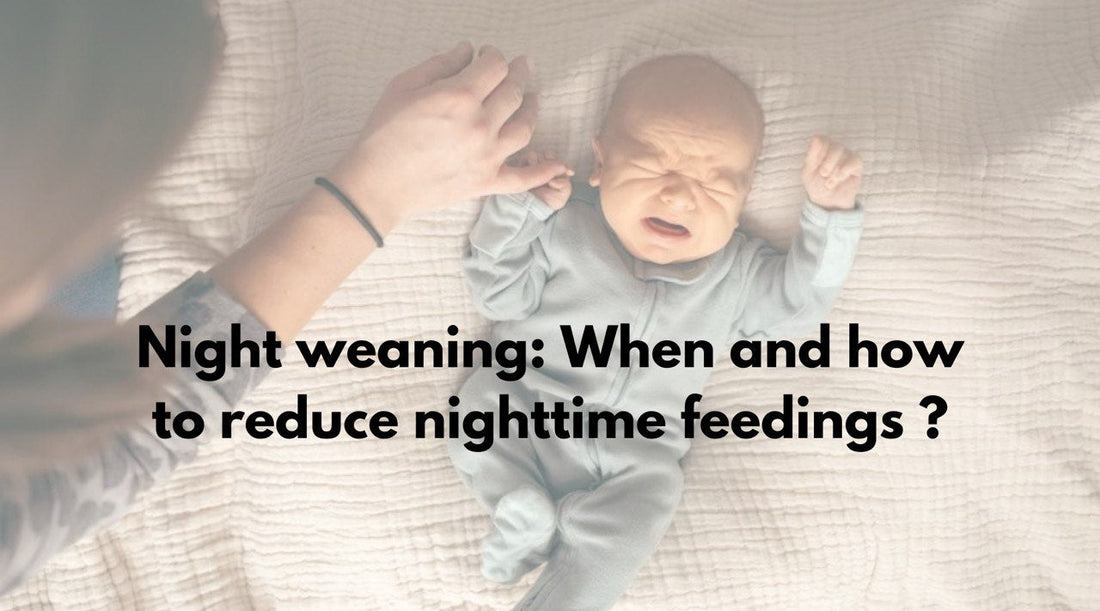
Night weaning: When and how to reduce nighttime feedings
Share
Every new parent hears warnings about sleepless nights, but nothing quite prepares you for the real thing—late-night feedings, diaper changes, and those wide-awake moments when the crib feels like a party zone. The good news? Babies eventually stop needing to eat during the night.
Here’s a clear look at when night weaning typically happens and how you can gently encourage fewer night feedings while still supporting healthy growth.
What is night weaning?
Night weaning means your baby no longer takes feedings between bedtime and their first morning meal. Some families consider their baby night-weaned if they can sleep a long stretch—about six to eight hours—without waking to feed. Others wait until every single overnight feeding has been eliminated. Whatever definition you use, the goal is the same: helping your baby (and you) get longer stretches of uninterrupted sleep.
Night feeding patterns by age
Every baby’s needs are different, but here’s a general idea of what’s typical:
Newborns (0–2 months): Frequent overnight feeds are normal—usually every 2–4 hours. A baby sleeping roughly 10 p.m. to 7 a.m. will likely wake two or three times to eat.
Around 3–4 months: Many babies are capable of slightly longer nighttime stretches, but most still benefit from two or three feeds to comfortably get through 10–12 hours of night sleep. Their nights are becoming longer and they’re more active, so a few overnight feedings remain common.
5 months and older: After about 5 months, many babies can manage one stretch of 5–6 hours without feeding. Between 7–8 months, many need only one night feed—or none. By around 9 months, it’s common for babies to sleep through without waking for food. Remember that these timelines vary widely.
When to begin night weaning
Once your baby is eating solids and their growth has slowed—often around 6–7 months—you can begin gradually reducing night feedings if they haven’t done so on their own. Some parents start by cutting down to one or two nighttime feeds before eliminating them completely. Every baby is unique, so check with your healthcare provider if you’re unsure whether your child is ready.
Tips for helping your baby night wean
Offer plenty of daytime calories. Feed your baby well during the day and consider a cluster feed in the evening to help them feel full overnight.
Try other soothing methods. Night waking doesn’t always mean hunger. Gentle rocking, soft singing, or offering a pacifier may be all that’s needed.
Reduce feeds gradually. If bottle feeding, slowly decrease the ounces offered at the first night feed. If breastfeeding, shorten the duration by a minute or two each night until it’s just a quick snack.
Lengthen time between feeds. If your baby wakes every two hours, aim for 2½ hours, then three, before feeding. If they wake earlier, soothe in other ways. If they can’t settle, feed them and try again the next night.
Encourage self-settling. If your baby always feeds to fall asleep, they may expect the same when they wake at night. Helping them learn to drift off at bedtime without nursing or a bottle can reduce wakings tied to comfort rather than hunger.
Extra note for breastfeeding parents:
As you reduce night feeds, continue to offer frequent daytime nursing. If your breasts feel too full, consider expressing or pumping to stay comfortable and protect your milk supply.
Takeaway
Night weaning is a gradual process, and the timeline differs for every child. Follow your baby’s cues and move at a pace that feels right for both of you. With patience and gentle consistency, those long nighttime stretches will arrive—and those endless midnight wake-ups will become a distant memory.
